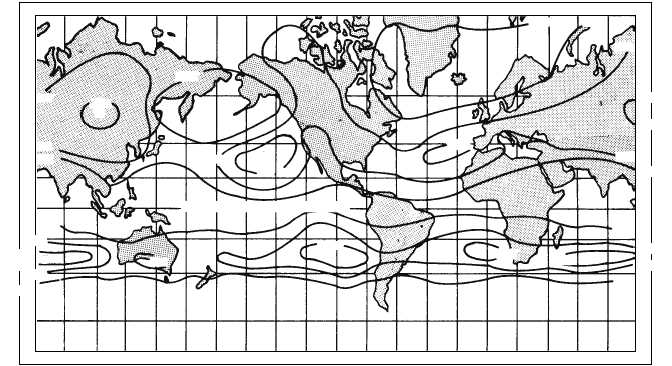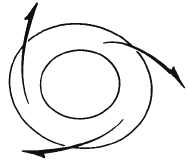The polar high in winter is not a cell centered
directly over the North Pole, but appears to be an
extension of the Asiatic high and often appears as a
wedge extending from the Asiatic continent. The cell is
displaced toward the area of coldest temperatures—the
Asiatic continent. In summer, this high appears as an
extension of the Pacific high and is again displaced
toward the area of coolest temperature, which in this
case is the extensive water area of the Pacific.
In winter over North America, the most significant
feature is the domination by a high-pressure cell. This
cell is also due to cooling but is not as intense as the
Asiatic cell. In summer, the most significant feature is
the so-called heat low over the southwestern part of the
continent, which is caused by extreme heating in this
region.
MIGRATORY SYSTEMS
General circulation, based on an average of wind
conditions,
is
a
more
or
less
quasi-stationary
circulation.
Likewise,
much
of
the
secondary
circulation depends on more or less static conditions
that, in turn, depend on permanent and semi permanent
high and low-pressure areas. Changes in the circulation
patterns discussed so far have been largely seasonal.
However, secondary circulation also includes wind
systems that migrate constantly, producing rapidly
changing weather conditions throughout all seasons,
especially in the middle latitudes.
The migratory
circulation systems are associated with air masses,
fronts, cyclones, and anticyclones. These are covered in
detail in the next unit.
Anticyclones
An anticyclone (high) is an area of relatively high
pressure with a clockwise flow (wind circulation) in the
Northern Hemisphere and counterclockwise flow in the
Southern Hemisphere. The windflow in an anticyclone
is slightly across the isobars and away from the center
of the anticyclone. (See fig. 3-15.) Anticyclones are
commonly called highs or high-pressure areas.
3-16
80
80
120
120
120
120
160
160
160
160
80
80
40
40
0
0
40
40
80
80
1012
1012
1016
40
20
0
1012
1020
1020
H
1012
60
60
0
20
40
1012
H
1020
1016
1012
H
1020
1601016
`1012
L
H
1016
1020
1020
H
AG5f0314
L
H
1020
1016
1020
1020
1012
1016
1016
1012
1020
10201016
1016
EQUATORIAL LOW PRESSURE BELT
Figure 3-14.—Average annual pressure distribution chart.
HIGH
ANTICYCLONIC
CIRCULATION
AG5f0315
Figure 3-15.—Anticyclone.




